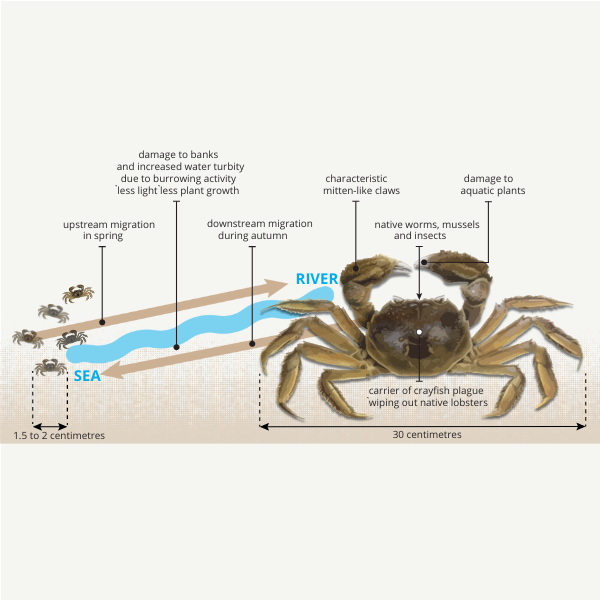
Distribution of the Chinese mitten crab in Europe. (Source: Ewers C, Normant-Saremba M, Keirsebelik H, Schoelynck J (2023): "The temporal abundance-distribution relationship in a global invader sheds light on species distribution mechanisms" Aquatic Invasions 18(2): 179–197.)
The life-cycle
The Chinese mitten crab is on the IUCN's list of the “world's 100 Worst Invasive Alien Species”. The crab is found in large numbers in practically all coastal waterways along the southern North Sea coast. The crab larvae develop in the salty coastal waters before migrating up the rivers in spring as young 1.5 to 2.5 cm sized crabs, still without the characteristic woolly claws. During the migration, they overcome walls of weirs and other obstacles until they reach their maturing habitats in canals, rivers and lakes. Here they grow into crabs with a leg span of up to 30 cm over the next three to five years. Every year in autumn, hundred of thousands of adult crabs make their way back to the sea to spawn. After reproduction they die of exhaustion.

Impact on the ecosystem
These large numbers of crabs have consequences for the aquatic ecosystems. As opportunistic omnivores, they rummage through the soil to prey on bottom-dwelling creatures such as worms, mussels and insects. In this way they predate on and compete with native species. Aquatic plants are occasionally eaten as well, but moreover the crabs cause serious damage to the plants with their claws. Next to this, the crabs damage riverbank structures and increase water turbidity through their burrowing activity. As a result, less light reaches the aquatic plants and they grow less well. The decline of the plants also increases the flow velocity in the rivers and canals, which also leads to an increased turbidity and a further decline of the plants.
However, juvenile mitten crabs are also welcome prey for many predatory fish, birds and otters. Therefore, the consequences for the river ecosystem are also being recorded in detail in this project.
